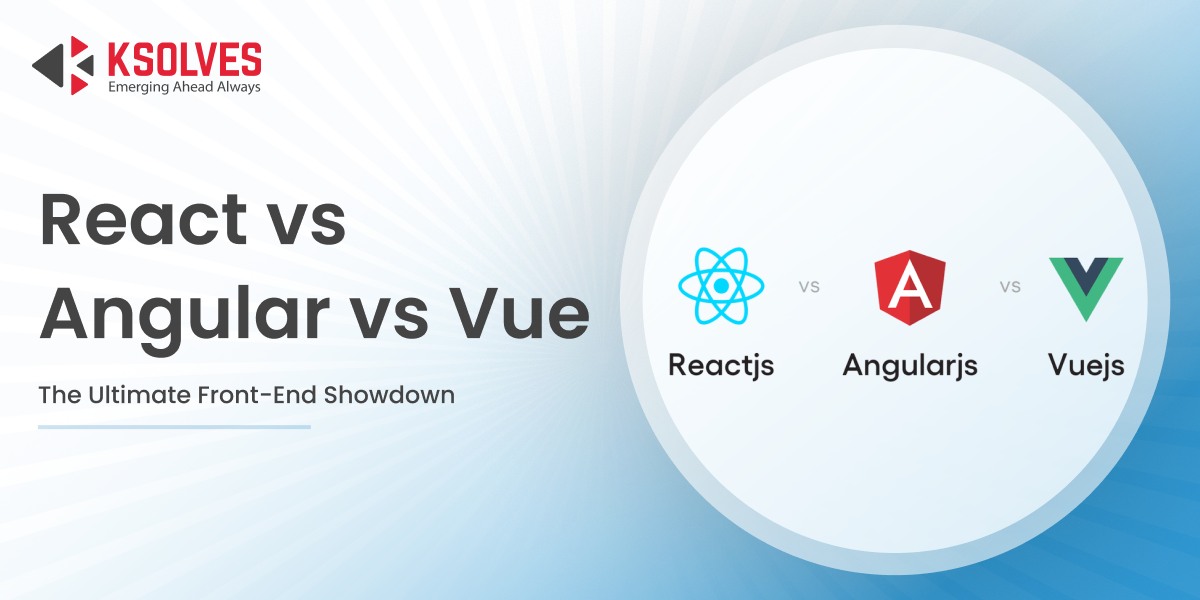How ReactJS Accelerates Product Development and Reduces Time-to-Market
ReactJS
5 MIN READ
November 6, 2025
![]()

In the world of digital innovation, every second counts, and your time-to-market could be the difference between being a market leader or just another follower. The faster you launch, the quicker you learn, adapt, and capture opportunities. But getting there? That’s often where teams hit a wall. Tangled codebases, slow iterations, and endless testing loops that stall momentum.
This is where ReactJS changes the game. Built for speed, scalability, and simplicity, React empowers developers to build dynamic interfaces in record time. It helps businesses bring their ideas to life before competitors even start sprinting.
From reusable components and instant reloading to a massive ecosystem of pre-built tools, ReactJS gives your product the boost it needs to hit the market faster.
In this blog, we’ll uncover how ReactJS accelerates product development, streamlines teamwork, and helps ambitious brands like yours move from idea to impact.
Understanding Time-to-Market (TTM)
Time-to-Market (TTM) measures how quickly a product moves from an idea to a fully launched solution. In today’s fast-paced digital landscape, a shorter TTM isn’t just an advantage – it’s a necessity. The faster a product reaches the market, the sooner a business can capitalize on opportunities, respond to evolving customer needs, and gain a competitive edge.
Yet, achieving rapid TTM is easier said than done. Many teams face common obstacles, including:
- Complex user interfaces that take excessive time to develop and refine.
- Rework due to unmaintainable code structures, slowing down progress.
- Limited reusability and collaboration challenges, causing delays across teams.
- Scaling and integration difficulties that can stall feature rollouts.
This is where ReactJS shines. By providing a flexible, component-based architecture, a powerful ecosystem, and efficient development workflows, React transforms slow, rigid processes into agile, collaborative, and rapid development cycles. It helps businesses bring products to market faster, smarter, and more reliably.
Top 6 Reasons Why ReactJS is a Game-Changer for Faster Product Launches
1. Component-Based Architecture: Build Once, Use Everywhere
One of React’s most powerful features is its component-based architecture. Instead of reinventing the wheel for every page or feature, developers can create reusable, self-contained UI components, such as buttons, forms, navigation bars, and cards.
This approach delivers multiple benefits:
- Consistency across the application: Each component behaves the same way wherever it’s used.
- Parallel development: Multiple teams can work on different components simultaneously without conflicts.
- Faster development cycles: Building with reusable pieces accelerates implementation and testing.
- Easier maintenance: Updates to a single component automatically propagate wherever it’s used, reducing bugs and technical debt.
In short, less duplication means more innovation. That’s the React advantage.
2. Virtual DOM: Speed Without Compromise
React’s Virtual DOM is a game-changer for building high-performance applications. Instead of updating the entire web page when a change occurs, React identifies only the components that need to be updated and re-renders them.
Why it matters:
- Faster rendering means users experience smoother interactions.
- Reduced debugging time as developers can pinpoint changes efficiently.
- Accelerated iteration cycles: Test and deploy new features quickly without slowing down the app.
Less wasted effort and more seamless performance, React makes it effortless.
3. One-Way Data Binding: Simplified Debugging and Clarity
React uses one-way data binding, which means data flows in a single direction — from parent components to child components. This predictable flow simplifies how applications handle data and reduces unexpected behaviors that often slow down development.
Key benefits:
- Simplified debugging and testing even in complex, large-scale applications.
- Clear data flow eliminates accidental overwrites and unintended side effects.
- Faster development cycles mean less rework and fewer errors, so your team can move quickly.
4. Hooks and Functional Components: Faster, Cleaner, Smarter
React Hooks empower developers to manage component state and side effects directly within functional components, eliminating the complexity and verbosity of traditional class-based structures.
Why it matters:
- Simpler, more readable code: Easier to maintain and scale over time.
- Faster prototyping: Implement new features quickly without restructuring the app.
- Efficient updates: Small changes stay isolated, so the rest of the system remains stable.
5. Hot Reloading: Instant Feedback Loops
React’s hot reloading feature allows developers to instantly see changes in the app without refreshing the entire page. This is particularly useful during UI/UX iterations or feature testing.
Why does it accelerate development?
- Immediate feedback loops improve productivity.
- Reduces downtime caused by manual refreshes.
- Enables rapid experimentation without risk to live components.
6. Ecosystem & Tooling: Speed Up Development
React is supported by a vibrant ecosystem of tools and libraries, making it easy to implement complex features quickly:
-
React Developer Tools & NPM Packages
React offers access to one of the largest open-source ecosystems in the world. From UI libraries like Material UI and Ant Design to charting tools, authentication modules, and testing frameworks, almost everything you need is just a few commands away.
-
Seamless Integration with TypeScript
React works seamlessly with TypeScript, providing type safety and early bug detection. This not only ensures cleaner, production-ready code but also reduces costly rework, keeping projects on track even under tight deadlines.
-
Ready-to-Use Build Tools
Build tools like Create React App, Vite, and Next.js drastically reduce setup time. Developers can move from concept to working application in minutes, not days, accelerating the entire development process.
-
React with Next.js: Perfect for MVPs and Production Apps
For startups or enterprises aiming for a rapid launch, Next.js (built on React) enables server-side rendering (SSR) and static site generation (SSG). This means apps are fast, SEO-optimized, and ready for production, all with minimal development overhead.
Potential Challenges with ReactJS and How to Overcome Them
While React offers tremendous speed and flexibility, teams may encounter certain challenges as they scale applications. Understanding these hurdles and knowing how to address them ensures smoother development and faster time-to-market.
1. Learning Curve
React’s ecosystem is vast, and newcomers may feel overwhelmed by the array of tools, libraries, and best practices.
How to overcome:
- Start small with core React concepts and gradually explore advanced features.
- Leverage React Docs and official tutorials for structured learning.
- Adopt component-driven development early to establish clean, maintainable code patterns.
Tip: Investing time upfront in learning React’s fundamentals reduces rework and accelerates long-term development efficiency.
2. State Complexity
As applications grow, managing state across multiple components can become challenging, potentially leading to bugs or inconsistent data.
How to overcome:
- Use state management solutions like Redux, Recoil, or Context API for predictable, centralized data flow.
- Maintain a clear separation of local vs. global state to keep the application manageable.
Tip: A well-planned state strategy prevents chaos and keeps development predictable, even as the app scales.
3. Performance Optimization
Large-scale applications can face performance bottlenecks if components are not optimized, impacting user experience and iteration speed.
How to overcome:
- Implement code-splitting and lazy loading to reduce initial load times.
- Use memoization techniques (e.g., React.memo, useMemo) to avoid unnecessary re-renders.
- Regularly profile and monitor your application to identify performance hotspots early.
Tip: Proactive performance management ensures that scaling your app doesn’t slow down development or user experience.
How Ksolves Helps Product Launch Faster with ReactJS
At Ksolves, we know that reducing time-to-market isn’t just about coding fast – it’s about strategic architecture, technical excellence, and seamless execution. Our ReactJS development services help businesses move from concept to launch quickly, reliably, and at scale.
Here’s how we make it happen:
- Agile & Component-Driven Development
We leverage React’s component-based architecture and React Hooks to build reusable, modular components. This ensures parallel development across teams, faster prototyping, and consistent UI/UX across the application.
- State Management Expertise
We implement Redux, Recoil, or Zustand to handle complex state management efficiently, ensuring predictable data flow and minimal bugs in large-scale applications.
- Performance Optimization
Our team uses code-splitting, lazy loading, memoization (React.memo, useMemo), and dynamic imports to improve rendering speed and reduce initial load time — crucial for user experience and faster iterations.
- Type Safety with TypeScript
We integrate TypeScript for large-scale projects to catch errors early, maintain robust codebases, and enable safer collaboration across development teams.
- Next.js & SSR/SSG Implementation
For startups or enterprises needing fast MVPs or production-ready apps, we use Next.js to deliver server-side rendered (SSR) or statically generated (SSG) pages, ensuring SEO optimization and instant load times.
- Testing & Quality Assurance
We adopt Jest, React Testing Library, and Cypress for unit, integration, and end-to-end testing, ensuring high-quality releases and reducing post-launch fixes.
- Scalable & Future-Proof Architecture
Our apps are designed for growth, with modular code, clean folder structures, and optimized state handling, reducing technical debt and making future feature additions seamless.
How Ksolves Accelerated Faster-to-Market for a Healthcare Appointment Platform
A healthcare startup needed a fast, scalable platform for appointments and teleconsultations, but slow development and performance issues were holding them back.
As a trusted ReactJS development company, we implemented a ReactJS-based solution. We built reusable components, implemented predictable state management, and optimized performance. The result? MVP delivered in 7 weeks (40% faster), 2–3x faster UI, and a platform ready to scale with new features.
Ksolves helped turn a complex challenge into a high-performing, future-ready healthcare solution.
Final Words
Speed and efficiency define success in today’s digital marketplace. ReactJS empowers businesses to shorten development cycles, enhance performance, and deliver high-quality applications faster. By leveraging its reusable components, virtual DOM, and robust ecosystem, teams can iterate quickly, respond to market changes, and launch products without compromising quality.
At Ksolves, we translate this advantage into real-world results. Our ReactJS expertise ensures scalable, maintainable, and high-performing solutions, helping businesses reduce time-to-market and maximize impact. Partner with Ksolves to accelerate your product journey and stay ahead in a competitive landscape.







AUTHOR
ReactJS
Share with